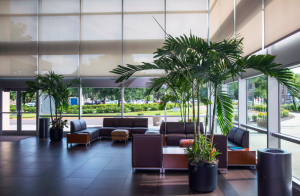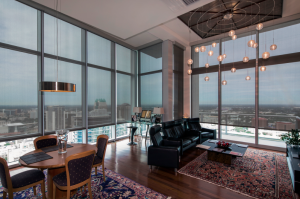Architects, designers and owners should consider four primary factors when selecting a roller shade fabric: color, weave/construction, openness factor and mounting position of the shades themselves.
Color

Color represents perhaps one of the most important choices, not only for aesthetic reasons, but also for how it affects shade performance in the window. Dark and light fabrics have strengths and limitations; specifying a color appropriate to the application is important:
- Dark-colored screen fabrics—with their natural room-darkening properties—reduce glare and improve visibility from the inside looking out. They also absorb more solar energy than light-colored fabrics; however, this can lead to a decrease in energy efficiency by allowing more radiant heat into the interior environment.
- By contrast, white and light-colored fabrics inherently reflect light to reduce solar heat gain. Their ability to filter glare is not as good, however, and the resulting room-brightening effect can lead to less visibility through shades to the outside view.
- Duotone (or two-sided) fabrics offer a strong alternative to single-colored dark or light fabrics. These fabrics offer a best-of-both-worlds solution with a lighter or reflective metallic surface to face the window glass and reflect heat and a darker surface to face the interior to reduce glare. The combination results in a high-performing fabric that maintains its room-darkening capabilities and superior view-through.
Construction
Fabric construction is an important consideration when we consider the three major types of fabric: PVC-coated polyester, PVC-coated fiberglass and PVC-free. Polyester core tends to be thicker in diameter than its fiberglass equivalent, resulting in a thicker and heavier fabric. The thicker and heavier the fabric, the larger the hardware and roller tube assembly must be to avoid deflection. Additionally, polyester yarns can stretch while fiberglass tends to be a more dimensionally stable fabric. This is important to consider when we want to keep a fabric hanging flat and true for its lifetime. As a general rule of thumb, fiberglass core fabrics are recommended for larger and taller window openings.
Although PVC-coated fabrics offer some clear advantages, including reduced fraying, easy care and cleaning, increased dimensional stability and resistance to stretching, among others, these fabrics contain VOCs (volatile organic compounds) that can reduce interior environmental quality by introducing an odor as they “offgas” in the first weeks or months of use. Advancements in fabric design and construction during the past decade have led to the introduction of PVC-free fabrics, which are a great alternative for interior spaces that may be more sensitive to odors (such as hospitals). Several PVC-free options exist, but the two most common are TPO (thermoplastic olefins) and PVC-free 100 percent polyester. Each has pros and cons: TPO fabrics have been known to experience color fading over time, for example, and some PVC-free polyesters are difficult to clean.

Openness
While less important than color and construction, openness factors still must be considered when selecting roller shade fabrics. Fabrics of different openness have different levels of UV blocking. A rule of thumb is that the amount of UV light blocked by the fabric is the inverse of its openness. For example, a 3 percent openness fabric blocks 97 percent of the UV light while a 10 percent openness fabric only blocks 90 percent of the UV light. In addition, openness factor affects a fabric’s shading and glare-filtering performance. Thus, the geographic location of the building should influence the choice of a particular openness. One percent and 3 percent open fabrics are very popular facing east, west and south façades in southern climates while 3 percent and 5 percent open fabrics are popular in northern climates. North-facing windows in both climates can often use 10 percent openness factors without allowing too much light or glare to pass through.
Mounting Position
The mounting position consideration relates not only to the mounting position of the roller shades in relation to the window, but also to whether a given project should utilize exterior shades versus interior shades. Like the other three considerations we’ve discussed, each option fits different applications: External shading is the most energy-efficient means of controlling solar gain because it blocks light radiation before it enters the building and becomes heat. This contributes up to 75 percent better energy efficiency compared to internal shades. However, external shading requires sensors to allow shades to retract in high-wind conditions. The addition of the sensors, as well as the need for more robust, exterior-grade hardware and fabric can raise the overall cost of the systems, making interior solutions more budget-friendly options in the short to medium term.
Most leading shading manufacturers offer educational resources and advisory services that can assist in evaluating various options. Architects and designers can contact their local manufacturer’s representative to review the specifics of a given project’s needs.


1 Comment
It’s interesting that windows that face north use 10% openness factors. My wife wants to install new roller windows to our living room this month so we can control the lighting that enters our home. We’ll be sure to find a good covering that has the right fabric we’re looking for.